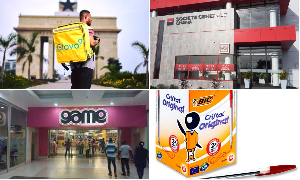- Home - News
- TWI News | TV
- Polls
- Year In Review
- News Archive
- Crime & Punishment
- Politics
- Regional
- Editorial
- Health
- Ghanaians Abroad
- Tabloid
- Africa
- Religion
- Election 2020
- Coronavirus
- News Videos | TV
- Photo Archives
- News Headlines
- Press Release
General News of Wednesday, 22 November 2023
Source: theheraldghana.com
COCOBOD trial: Court told state’s star witness ‘doctored’ testimony in committee report
There was a bombshell in court yesterday as it emerged that a document the state heavily relied on as part of evidence to prosecute former COCOBOD boss Dr. Stephen Opuni and two others was allegedly doctored and tendered in evidence through the third prosecution witness, Dr. Yaw Adu-Ampomah.
The document in question is the report of a committee constituted by the Akufo-Addo government in 2017, chaired by Dr. Adu-Ampomah, a former Deputy Chief Executive of COCOBOD, who was recalled from retirement to head the transition team at COCOBOD, primarily to interrogate the activities of the previous administration.
The committee ostensibly investigated alleged fertiliser testing anomalies at the Cocoa Research Institute of Ghana (CRIG).
The report claimed that a former Executive Director of the Cocoa Research Institute of Ghana, Dr. Anim Kwapong, told the committee that lithovit fertilizer used to be powder in nature. But this claim has been flatly discredited by him.
The former COCOBOD Chief Executive, Dr. Opuni and businessman Seidu Agongo, as well as Agricult Ghana Limited, have been facing 27 charges, including defrauding by false pretense, willfully causing financial loss to the state, corruption by public officers and contravention of the Public Procurement Act in the purchase of Lithovit liquid fertiliser between 2014 and 2016.
They have pleaded not guilty to the charges and are on a GH¢300,000.00 self-recognizance bail each.
Dr. Anim Kwapong, giving his evidence in chief as a subpoenaed witness on Tuesday, November 21, 2023, told the court that he vividly recalled telling the committee that lithovit fertilizer was a liquid substance.
The witness indicated to the court that he was surprised that the committee included in its report that he said lithovit was powdered, adding that he was seeing the report for the first time in court, years after it was compiled by the Adu-Ampomah committee.
“You were speaking the truth when you informed the committee that the first sample of Lithovit that 'I saw personally was liquid, and I didn’t have any idea that in the past it was powder, it was recently that I got to know that it was powder, that was the truth isn’t so?” Counsel for Dr. Opuni, Samuel Codjoe asked the witness.
Dr. Kwapong maintained, “My Lord, I have not seen this document before, this is the first time I’m seeing the proceedings of the committee, indeed I mentioned the first time I saw lithovit was liquid, but this continuing statement saying I got to know that it was powder, I don’t believe I said that. The first time I saw the sample it was liquid and it was bottle. My Lord, this sentence being attributed to me [that lithovit was powder] cannot be right.”
His testimony to the committee was contained in pages 42 to 45 of the Adu-Ampomah Committee report, which is in evidence as Exhibit H.
When asked by counsel that what he told the committee “was the truth”, the witness answered in affirmative, “My Lord I always stand by what I say, it is the truth”.
Dr. Anim Kwapong, who renewed the certificate of lithovit liquid fertilizer in 2016 took the court through how fertilizers are certified and renewed at CRIG.
“The Committee for Testing Chemicals and Machines (CTCM) will make sure that the requisite payment would have been made. They provided to me a field report, this field report contains information on field studies they have carried out on all agrochemicals and machines used in previous years. During the period when certificates had been issued and chemicals had actively been used in the field.
“So the committee collects information about the efficacy of the product, farmers’ reactions and comments about the product they have used. They also pick samples of the product on the market and from other sources for testing at CRIG. They also check that the labels on the product conform to the information that was originally provided to the scientist.
“They write an annual report, titled CODAPEC Evaluation Report. With that report, I’m able to know chemicals that have passed the test in the field. And when they are submitting the renewal certificate to me they attach the expired certificate. So with this information available to me, I’m able to sign the certificate. I do that for all the certificates that I signed. So in signing the first certificate, the first certificate here was attached to the one that I signed in 2016 and they had paid for the renewal, and there was no adverse mention or anything or report in the CODAPEC Evaluation Report so I went ahead and signed.”
Read excerpts of Tuesday’s proceedings
Q. Dr. Anim Kwapong, at the last adjourned date you talked about chemicals applied to cocoa and you mentioned insecticide, fertilizers and fungicide. Do you remember
A. My Lord, yes I do remember
Q. Can you tell the court the types of fertilizers which apply to COCOBOD
A. My Lord, we have granular fertilizers that is solid and liquid fertilizers
Q. Can you tell the court how a particular fertilizer would be introduced to COCOBOD
A. My Lord, a company wishing to introduce fertilizer to be used on cocoa farms, would have to apply to the office of the deputy chief executive in charge of agronomy and quality control.
Q. and what happens after the application
A. Deputy Chief Executive informs CRIG about the application and direct that CRIG takes samples for testing
Q. Can you tell us the process of testing
A. Once the letter is received and the chemicals are included, there is a committee, the name is Committee for Testing Chemicals and Machines (CTCM) . The committee identifies the appropriate division at CRIG for testing the chemical. They determined together the modalities or methodologies for testing the chemicals. We also together, determine the site, that is areas where the chemical would be tested. My Lord, the committee also work together to determine the cost of the testing. My Lord, there are several works that they do, my Lord I provided details of the terms of reference for the CTCM and in the report I presented to EOCO. My Lord, it is my wish that if this document is made available we can see all that I’m referring to. So in short, the CTCM oversees and coordinate all activities related to the testing of agrochemicals and machines at CRIG. Thank you.
Q. Do you know about the fertilizer called lithovit
A. My lord, yes I do
Q. How did you know about lithovit
A. My Lord, I initially knew about lithovit because it was mentioned to me at CRIG.
Q. If you initially knew about lithovit because it was mentioned to you at CRIG, did you subsequently also know about lithovit
A. My Lord, the second instance was when it was brought to my attention again at an investigative committee meeting
Q. When was lithovit introduced to COCOBOD
A. My Lord I don’t know
Q. When you were the executive director of CRIG, can you mention the names and types of the fertilizers and specifically, foliar fertilizers
A. My Lord, during my tenure we have over 90 agrochemicals that were being tested and I cannot recall their names and types.
Q. But you remember when you appeared before the committee they asked you about fertilizers that were used during your time as the executive director of CRIG, isn’t it
A. My Lord I don’t remember any such things, it has been a while
Q. Can I have exhibit H. Have a look at page 42, 13.0 of exhibit H, in it you have the evidence of Dr. Anim Kwapong, and it extends to 45 is that not so
A. That’s true
Q. Do you recollect that you were specifically asked questions on testing of Lithovit fertilizer by the committee chaired by Dr. Adu-Ampomah
A. My Lord per what is before me I confirm that, I did mention what he is referring to
Q. In fact, what you told the committee was the truth, is that not so
A. My Lord, I always stand by what I say, it is the truth
Q. You were speaking the truth when you informed the committee that the first sample of Lithovit that “I saw personally was liquid, and I didn’t have any idea that in the past it was powder, it was recently that I got to know that it was powder” that was the truth isn’t so
A. My Lord, I have not seen this document before, this is the first time I’m seeing the proceedings of the committee, indeed I mentioned the first time I saw lithovit was liquid, but this continuing statement saying I got to know that it was powder, I don’t believe I said that. The first time I saw the sample it was liquid and it was bottle. My Lord, this sentence being attributed to me cannot be right.
Q. So until today, have you seen a copy of the committee’s report
A. My Lord no.
Q. Are you saying you were not given a copy
A. My Lord, I was not given a copy
Q. Before the committee, you informed the panel that you were not directly in charge of testing, do you stand by it
A. My Lord, I stand by it, I’m not in charge of testing
Q. If you say you were not responsible for the testing, who was responsible for the testing and how was it done
A. My Lord, when I assumed office as the executive director there was already existed a committee that had oversight responsibility and also coordinated the testing of all agrochemicals and machines. They collate all the reports and recommendations, and once they are satisfied with what they have collected, they bring a report containing all the recommendations to my desk for my signature. I just didn’t go through it, I also do due diligence before appending my signature to the document report presented for my signature.
Q. You have before you exhibit 4 and 4a, these are renewal certificate for lithovit foliar fertilizer, who signed these certificates for their renewal
A. My Lord, I signed both certificates, but the first certificate signed in 2015 is not for renewal. It appeared to me and at the time, and per the records that I checked there was no indication that the first I signed was for a renewal. I signed the second one in 2016 as a renewal
Q. What is the name of the fertilizer there and what type of fertilizer is lithovit
A. My Lord as indicated I am not a soil scientist or expert in fertilizers. I have indicated earlier that Lithovit was mentioned to me and I had seen a bottle containing a liquid containing the brand name. So I have continuously used the brand name instead of chemical name, the brand name was lithovit.
Q. On page 44 of exhibit H, you were asked what was the basis of the renewal of Lithovit certificate. Can you tell us what your basis was.
A. My Lord, sometimes companies per our rules would make a formal request for certificate renewals
The Committee for Testing Chemicals and Machines (CTCM) will make sure that the requisite payment would have been made. They provided to me a field report, this field report contains information on field studies they have carried out on all agrochemicals and machines used in the previous years. During the period when certificate had been issued and chemicals had actively been used in the field. So the committee collects information about the efficacy of the product, farmers’ reactions and comments about the product they have used. They also pick samples of the product on the market and from other sources for testing at CRIG. They also check that the labels on the product conform to the information that was originally provided to the scientist. They write an annual report, titled CODAPEC Evaluation Report. With that report, I’m able to know chemicals that have passed the test in the field. And when they are submitting the renewal certificate to me they attach the expired certificate. So with this information available to me I’m able to sign the certificate. I do that for all the certificates that I signed. So in signing the first certificate, the first certificate here was attached to the one that I signed in 2016 and they had paid for the renewal, and there was no adverse mention or anything or report in the CODAPEC Evaluation Report so I went ahead and signed.
Q. In your time as the executive director of CRIG, didn’t you meet the first accused who was the CEO of COCOBOD
A. My Lord as the executive director I met my boss as the CEO.
Q. Can you remember the number of occasions
A. We met several times at meetings in the boardroom but I cannot remember the number of times we had meetings in the boardroom. I also met him at a forum at one of CRIG s stop stations at Acherensua/Mabang. It was a visit to the stop station and I had to be there to receive him as the executive director. We also met at CRIG when we organized the farmers day in 2016, I met him, we hosted it. My Lord that is as far as I can remember
Q. Can you tell us the nature of the discussions concerning your work, if any, you had with the first accused during the period you were the executive director at CRIG
A. My Lord there is no occasion I had personal interactions with him, it was the usual welcome ceremony. At meetings in the boardroom, it was general discussions per the agenda or agendum for the meeting. So far that is what I can say.
Q. My Lord, I require the proceedings to enable me continue, as I want to show him the evidence on record with respect to testimonies of the prosecution witnesses and their cross examinations indicating that the first accused micro manage things.











